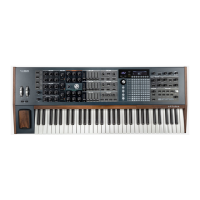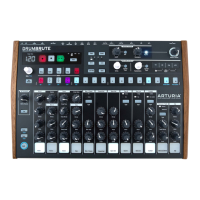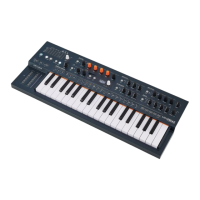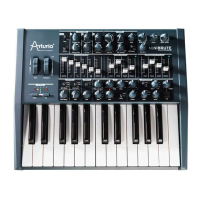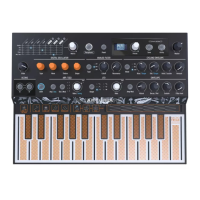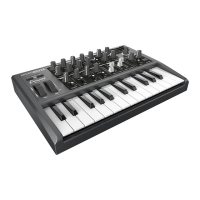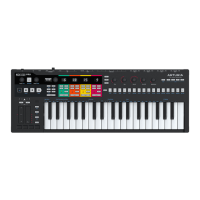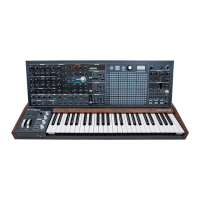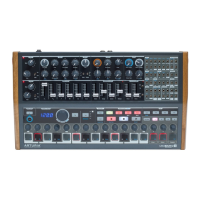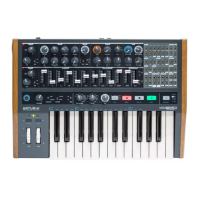Do you have a question about the Arturia ACID V and is the answer not in the manual?
Details the history and resurgence of the Roland TB-303 Bass Line synthesizer.
Explains the benefits and key advantages of using the Acid V software emulation.
Lists the main sonic and functional capabilities of the Acid V virtual instrument.
Suggests influential music tracks featuring the TB-303 for listener inspiration.
Step-by-step process for registering, activating, and installing the Acid V software.
Configuration of audio and MIDI settings for using Acid V as a standalone application.
Instructions for basic interaction and testing of Acid V after installation.
Details common interactions like value pop-ups, parameter descriptions, fine adjustment, and double-click defaults.
Explains the main synth engine parameters: Waveform, Pitch, Cutoff, Resonance, Env Mod, Decay, Accent, and envelope.
Covers controls for the sub-oscillator, including Octave, Waveform, and Volume.
Details the Vibrato controls for Speed and Amount, applied to specific sequence steps.
Explains the Drive knob, Dry/Wet balance, and available distortion algorithm types.
Describes the interface for pattern playback, including mode buttons, Hold, legato, and pattern info display.
Details advanced sound shaping options like Bass Boost, PW, Accent Attack, Cutoff Range, Pitch Tracking, Noise Gain, and Clipper.
Explains how to select and manage the sequencer and its lock function.
Covers graphical pattern creation: length, steps, octave, randomizers, accents, slides, and vibrato.
Details saving, sharing, clearing, and duplicating patterns within the sequencer.
Explains how to search, load, and import sequencer patterns.
Covers setting musical scales and custom scales to influence sequence notes.
Explains tempo synchronization options for Rate and the function of Gate Time.
Details the Swing control for adding rhythmic feel to patterns.
Describes different sequence playback modes: Forward, Backward, Forward Backward, and Random.
Explains step count adjustment and pattern transposition/rotation.
Covers Polymetric mode for independent step length control and Polymetric reset.
Explains the Generate and Density functions for altering sequence characteristics.
Details how the sequencer functions as an arpeggiator, including note input and playback order.
Explains how to assign modulators to parameters and control modulation amounts.
Details modulator creation using breakpoints and grab handles, and available modulation presets.
Explains Polarity, Mode (One/Loop/Run), and Retrigger events for modulator behavior.
Covers setting modulator rate with tempo sync options and the Scale parameter.
Describes the serial signal flow for effects within Acid V.
Details how to choose from the 17 available effects categorized into five types.
Explains using factory presets, saving custom presets, and copying effects between slots.
Introduces individual effect types, parameters like Dry/Wet, and tempo sync options.
Details the Reverb effect parameters: HPF, LPF, Pre-delay, Decay, Size, Damping, and MS Mix.
Covers Delay, Tape Echo, and PS Delay parameters for creating echo and pitch-shifting effects.
Explains Compressor and Multiband Compressor parameters for dynamic range control.
Details the Multi Filter and Param EQ effects for tone shaping.
Covers Distortion and Bitcrusher effects for adding grit and lo-fi character.
Explains Super Unison, Chorus, Flanger, Phaser, and Stereo Pan effects for sonic movement.
Describes the Main Menu, Preset Browser access, output volume, Advanced View, and Gear icon.
Details the Control Description display, Hold duplicate, Undo/Redo/History, CPU Meter, and Macro controls.
Introduces the Side Panel containing Settings, MIDI, Macros, and Tutorials tabs.
Selects the MIDI channel(s) on which Acid V will receive MIDI input.
Grants access to computer's system-level accessibility tools for Acid V.
Sets the velocity sensitivity for triggering accents in Ext mode.
Selects the MIDI controller and loads templates for Arturia or third-party devices.
Manages MIDI maps by saving, loading, or deleting controller assignment setups.
Details the process of mapping MIDI controller elements to Acid V parameters.
Explains MIDI channel, CC numbers, and scaling values for parameter assignments.
Provides options for assignment modes (Absolute, Relative) and parameter changes.
Lists reserved MIDI CC numbers that cannot be reassigned to controls.
Details selecting and renaming the four available Macro slots.
Explains assigning parameters to Macros and scaling their Min/Max values.
Covers customizing curves to control parameter response when turning a Macro knob.
Explains how to search for presets using text strings and filtering by type or style.
Details filtering presets by Types, Styles, and Banks for efficient browsing.
Covers sorting presets, clearing tags, liking presets, and shuffling results.
Explains navigating the sidebar for Sound Banks, Favorites, and Playlists.
Details viewing and editing preset information, including tags, comments, and organizational options.
Describes alternative ways to select presets via drop-down menus and type-based submenus.
Introduces the Macro knobs and their function in controlling multiple parameters.
Covers creating, adding, reordering, removing, and managing playlists and songs.
Defines Arturia's ownership of the SOFTWARE and its media, stating the license is not a sale.
Outlines Arturia's non-exclusive license terms for software use, prohibiting leasing or sub-licensing.
Explains compulsory activation and registration for license control and protection against copying.
Details support availability, upgrades, and updates contingent on product registration.
Prohibits modifying or unbundling software components for redistribution or resale.
Specifies conditions for transferring software usage rights to another person.
Clarifies requirements for using upgrades/updates and the expiration of support for prior versions.
States warranty limitations for software media defects and implied warranties.
Defines Arturia's liability and customer remedies for software defects, including warranty void conditions.
Excludes all other warranties, expressed or implied, not covered by the limited warranty.
Limits Arturia's liability for indirect or consequential damages arising from software use.
| Engine | Virtual Analog |
|---|---|
| Audio Outputs | Stereo Output |
| Effects | Delay, Reverb, Distortion, Phaser, Chorus |
| Compatibility | AAX, Audio Unit |
| Waveforms | Sawtooth, Square, Triangle |
| Envelopes | ADSR |
| LFOs | 2 LFOs with multiple waveforms |
| System Requirements | 4GB RAM, 2GHz CPU |
| Plugin Formats | VST, AU, AAX |
| MIDI | Full MIDI support |


